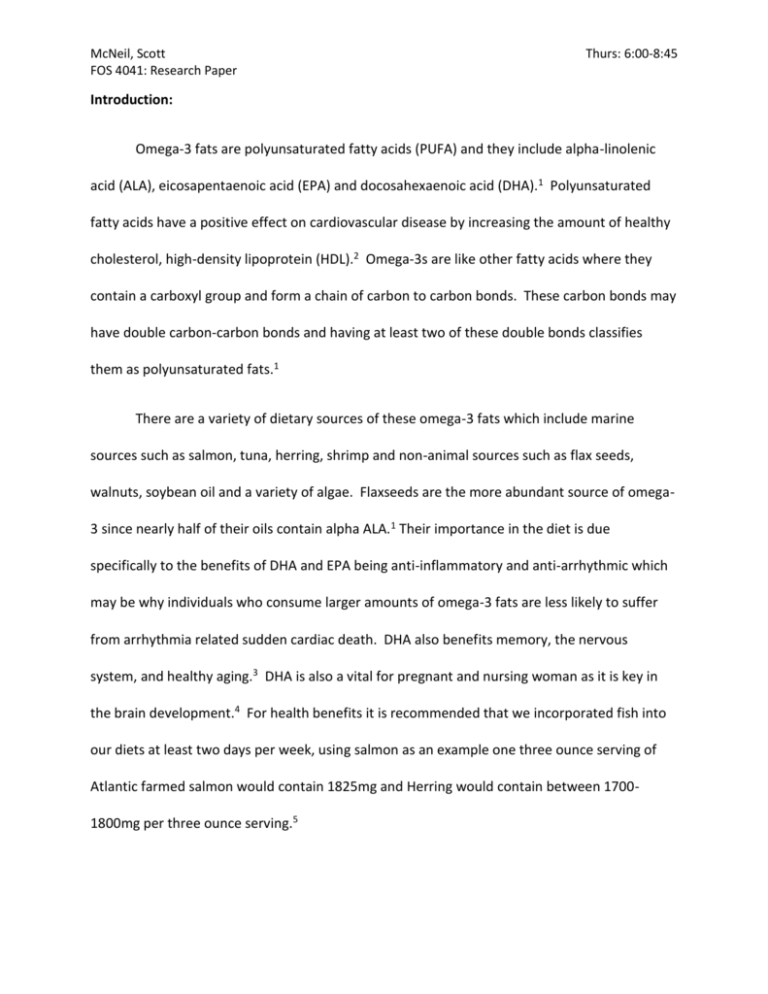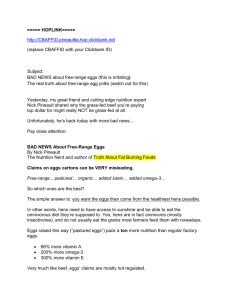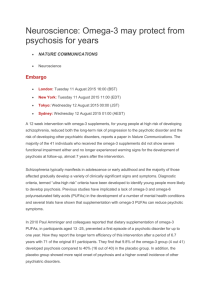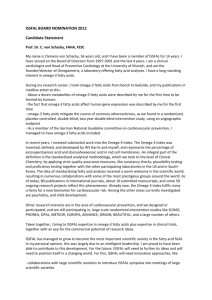click here - Scott McNeil Nutrition & Dietetic Portfolio
advertisement

McNeil, Scott FOS 4041: Research Paper Thurs: 6:00-8:45 Introduction: Omega-3 fats are polyunsaturated fatty acids (PUFA) and they include alpha-linolenic acid (ALA), eicosapentaenoic acid (EPA) and docosahexaenoic acid (DHA).1 Polyunsaturated fatty acids have a positive effect on cardiovascular disease by increasing the amount of healthy cholesterol, high-density lipoprotein (HDL).2 Omega-3s are like other fatty acids where they contain a carboxyl group and form a chain of carbon to carbon bonds. These carbon bonds may have double carbon-carbon bonds and having at least two of these double bonds classifies them as polyunsaturated fats.1 There are a variety of dietary sources of these omega-3 fats which include marine sources such as salmon, tuna, herring, shrimp and non-animal sources such as flax seeds, walnuts, soybean oil and a variety of algae. Flaxseeds are the more abundant source of omega3 since nearly half of their oils contain alpha ALA.1 Their importance in the diet is due specifically to the benefits of DHA and EPA being anti-inflammatory and anti-arrhythmic which may be why individuals who consume larger amounts of omega-3 fats are less likely to suffer from arrhythmia related sudden cardiac death. DHA also benefits memory, the nervous system, and healthy aging.3 DHA is also a vital for pregnant and nursing woman as it is key in the brain development.4 For health benefits it is recommended that we incorporated fish into our diets at least two days per week, using salmon as an example one three ounce serving of Atlantic farmed salmon would contain 1825mg and Herring would contain between 17001800mg per three ounce serving.5 McNeil, Scott FOS 4041: Research Paper Thurs: 6:00-8:45 When looking at omega-3 enriched eggs, typically hens are fed a diet that incorporates some source of ALA. The human body is able to convert ALA into EPA by the process of removing a hydrogen atom and the addition of two carbon atoms. The EPA than goes through an elongation and a process of desaturation to from DHA, both of these conversions, ALA to EPA and EPA to DHA are limited in the body.4 Understanding the value of obtaining omega-3 fatty acids in our diets, for this research paper we will look specifically at obtaining these fatty acids through egg products enriched with omega-3. We will divulge into a wide variety of studies and exam the effects on consumer acceptability, such factors as texture, taste, aroma and appearance. But most importantly answer what properties make omega-3 fats a healthy functional food ingredient for eggs. Physical Properties that make omega-3 a suitable functional food ingredient in eggs: In comparison to conventional and organic eggs, omega-3 enriched eggs offer similar physical structures which make them an ideal functional food ingredient. The aspects of egg weight, yolk size, amount of albumen per egg are all relatively close to traditional eggs. The distribution of fats are where differences are seen, total saturated fat in omega-3 eggs are lower than both the conventional and organic egg and the polyunsaturated fat and omega-3 content is significantly increased. Importantly for health purposes, omega-3 enriched eggs are bioavailable which allows humans to reap the cardiovascular benefits from omega-3.6 Omega-3 content is increased in a hens feed by several different measures, adding fish oil, flaxseeds, flaxseed oil or by algae which is very rich in omega-3 but may lead to a reddish color to the yolk McNeil, Scott FOS 4041: Research Paper Thurs: 6:00-8:45 due to its high carotenoid content. These were effective sources of omega-3 fats that did not show significant differences in aroma or taste.7 Omega-3 as a functional food may also be used in products such as liquid eggs; these products can sometimes be less preferred because of their taste. The popularity of liquid eggs is because with the lack of a yolk these alternatives provide a consumer with an egg option that is lower in cholesterol and fat. Given the fact that adding omega-3 fats to hens feed increases the eggs omega content in the yolk makes this mechanism an unreliable one for omega-3 containing liquid eggs. One study decided to look at the physical properties as to why different sources of omega-3 fats would be suitable additive to liquid eggs and why these improvements would increase consumer acceptability to liquid eggs. This study compared store bought whole eggs, liquid eggs (Egg BeatersTM) and used five different plant and animal sources of omega-3 to add to fresh egg whites the sources of omega-3 fats were, flaxseed oil, menhaden oil, krill oil and two different forms of algae oil. These eggs were all tested using three methods of testing for texture, the Kramer shear test, torsion test and the texture profile analysis (TPA) which all showed no significant differences in texture from the different liquid eggs. Typical liquid eggs provide a consumer a low calorie food that only provides them with a source of protein. The fat that is added in the form of various omega-3 sources allows for the sensory benefits of fat that include mouth feel, chewiness, texture also when cooking the protein gels and traps fat molecules which effect the flavors of a dish.8 In attempted to reduce the oxidative damage from omega-3 fats in eggs enriched by feeding hens a diet of flax seeds, researchers from Oregon State University, University of McNeil, Scott FOS 4041: Research Paper Thurs: 6:00-8:45 Veterinary and Animal Sciences, Lahore, Pakistan, University of Sargodha, Pakistan and University College of Agriculture tested the sensory effects of adding different antioxidants to the feed to help reduce this lipid oxidation which would than in turn increase consumer likability of such enriched eggs. The study was collaborated to test the sensory evaluation of omega-3 eggs from hens fed different amounts of flax seed; the control was 0% flax, 10% flax, 10% flax and 100IUmg/kg of Vitamin E or 10% flax and 100mg/kg of butylated hydroxytoluene (BHT). The butylated hydroxytoluene and Vitamin E acted as antioxidants to prevent omega-3 oxidation within the yolk. This test set out to establish a sensory evaluation of the omega-3 eggs and was broken up into three categories; those who were trained sensory panelists and two groups of untrained panelists. The first group was the trained panelist which included persons from the Oregon State University Food Science and Technology Department as well as others from a local community college. The second group was an untrained group which included students and staff of the University of Veterinary and Animal Sciences, Lahore, Pakistan and the final group, group three was random customers selected from grocery stores in Lahore, Pakistan. All groups were given the control (0% flax), the trained panelists were unaware of which sample(s) were the control and both untrained groups were given the triangular test, they were given three hard boiled eggs, two of which were the control and another was one of the variety of omega-3 eggs from either flax or flax and one of the two antioxidants, Vitamin E or BHT. The differences between the two untrained groups and the trained panelist was on the sensory evaluation questions, the untrained panelist were asked to evaluate flavor and aroma whereas the trained panelist were also asked about off-flavor and overall differences. The trained panelist results revealed their ability to take note to the McNeil, Scott FOS 4041: Research Paper Thurs: 6:00-8:45 differences from the controlled egg, specifically on flavor evaluation. Also the antioxidants, Vitamin E and BHT added to the eggs did not offer more acceptability of the omega-3 eggs to the trained panelists. To the untrained panelist there were no significant differences in either aroma or flavor when comparing the omega-3 eggs to the controlled eggs.9 Effects of omega-3 fats on egg storage and composition Storage of omega-3 enriched eggs can have effect nutritive values after specific lengths of time in a refrigerator. One particular study examined the effects of storing omega-3 eggs for 60 days at 4o Celsius and then were divided into four subcategories of fatty acid analysis, the first group was analyzed as is, the next after pasteurization, the third group after hard-boiling and the final group after scrambling. The control group was tested immediately without being stored in the refrigerator. This study also used two different sources of omega-3 in the hens feed; they used linseed oil or sunflower oil. The results of this study were interesting, all groups saw a decrease in the omega-3 polyunsaturated fatty acid content.10 The reason for decrease in polyunsaturated fatty acids is due to the fact that these long chain fatty acids are oxidized. The addition of various antioxidants can slow this process down, one particular study on storage of omega-3 eggs utilized alpha-tocopheryl acetate or olive leaves. To test the effectiveness of these antioxidants the researchers measured the MDA of the yolk, this is used as an indicator of lipid oxidation. The higher the levels of MDA found within the yolk the more lipid oxidation that has occurred, leading to an unpleasant texture quality.11 McNeil, Scott FOS 4041: Research Paper Thurs: 6:00-8:45 Omega-3 benefits to preventing macular degeneration: Age related macular degeneration is the leading cause worldwide of vision loss. Luein and zeaxanthin both act to limit oxidative damage to the eyes by acting as antioxidants. 12 Age related macular degeneration has a direct correlation with dietary intake of lutein and its stereoisomer zeaxanthin which is found in the macula. Both eggs and omega-3 are natural sources of lutein, with the omega-3 eggs supplying upwards of 15 times more lutein than the 0.44mg/100g yolk in a regular egg. The study published by the European Journal of Clinical Nutrition was an original article that looked at the effects of adding omega-3 enriched eggs or organic eggs as a measure to increase the serum lutein levels of lacto-ovo-vegetarians. This study concluded that although omega-3 enriched eggs contained a much greater content of lutein as opposed to the organic eggs they both had similar significant increases in serum lutein levels, the omega-3 egg group saw an 18% increase whereas the organic egg group saw a similar 17% increase in serum lutein levels.13 Lutein from eggs is the most biological ready form to the body.14 Conclusion: According to the Academy of Nutrition and Dietetics stance on functional foods eggs enriched with omega-3 fatty acids may reduce cholesterol but the strength of evidence is categorized as weak to moderate.15 These provide consumers with a convent way to incorporate omega-3 fats into their diet, these are beneficial to cardiovascular health which may be important to a client seeks consultation. The inconvenience to omega-3 eggs is most are in the ALA form, which the human body is limited in its conversion to EPA, and finally the McNeil, Scott FOS 4041: Research Paper Thurs: 6:00-8:45 EPA is converted to DHA which is critical for brain development and important to pregnant and nursing mothers.4 Eggs enriched with omega-3 fatty acids provide consumers with option of adding essential fatty acids to their diets without consuming fish, flaxseeds or taking a supplements. The sensory evaluations are relatively positive for aroma, taste, texture and other sensory traits by most untrained pallets, trained panelist although may have the ability to taste differences in omega-3 eggs compared to traditional eggs.4,5 Omega-3 fats have many positive benefits to the body, one of which is being a source of lutein, also found in eggs and although combining the two gave a significant increase in the overall milligram weight value of lutein it did not have as significant of an increase in serum lutein levels in comparison to organic eggs without added omega-3. This is may be attributed to the fact that eggs are one of the most bioavailable sources of lutein to our bodies, so in theory increasing an eggs lutein content by adding omega3 fats does not mean the added lutein has also has the same bioavailability as that which is found in the egg.6,7,8 An interesting aspect when feeding hens a diet that increases the amount of omega-3 found in the yolk is that these fatty acids oxidize at an increased rate due to the fact that omega-3 fats are more susceptible to oxidation, this also has an effect on shelf life since the oxidation of eggs leads to an unpleasant taste and aroma, this oxidation is slowed by adding various antioxidants to the feed as well such as Vitamin E.3 Application to Dietetics: Clients may be interested in incorporating omega-3 eggs into their diet for many reasons but most likely as a method to add these beneficial fatty acids to their diet in place of or in addition to other sources of omega-3. When reviewing these enriched eggs, the source of McNeil, Scott FOS 4041: Research Paper Thurs: 6:00-8:45 omega-3 used is ALA, which requires some conversion by the body to be properly utilized, first converted to EPA and then DHA, remembering this process is limited by the human body so this is not the most efficient way to achieve DHA through the diet. Most of these eggs contain between 100-150mg of omega-3 although some may be higher and when compared to other sources of this fatty acid such as salmon, herring, flaxseed, tuna, and even crustaceans fish such as shrimp the omega-3 eggs provide a relatively small amount of omega-3 fats. Considering for example salmon which contains 1800mg of omega-3 per three ounce serving if a client followed the recommended two weekly servings of fish they would accumulate 3600mg of healthy omega-3 per week which means in theory they would have to consume 24 omega-3 enriched eggs per week to equal these recommendations. When considering the value or worth of these enriched eggs in the diet we must think of a wide variety of situations, lifestyle, someone who may be a lacto-ovo-vegetarian may see benefits or enjoy variety in their diet as to consuming omega-3. Parents who may have children who are “picky” eaters may benefit from these omega-3 eggs as well ensuring their children at least get some source in their diet, this may also open the door later in life when a child can correlate omega-3 with being something they see on their egg carton, which they like that may lead them to trying other sources of omega-3. Although for most clients the cost factors which would be about $3.59 per dozen omega-3 eggs as opposed to $3.29 for a dozen and a half traditional eggs on top of the relatively low values of omega-3 found in these enriched eggs may not be worth adding in their diets. But it is important to understand these products and what they offer since there may be a client whose needs this product will address. Going forward it would be interesting to see if omega-3 usage as a functional food in eggs like McNeil, Scott FOS 4041: Research Paper Thurs: 6:00-8:45 products such as liquid eggs could be more economical than the traditional hen feed omega-3 eggs. These liquid omega-3 eggs may be a more suitable replacement in baking recipes because of the fat provided by the omega-3 to serve a similar for a similar texture which would be more appealing to consumers. Overall omega-3 fats provide a suitable functional food in eggs and liquid eggs because of its textural similarities that consumers expect when tasting eggs, they are fatty acids that blend well with eggs ability to act as an emulsifying agent. McNeil, Scott FOS 4041: Research Paper Thurs: 6:00-8:45 References: 1. Calder P, Yaqoob P. Omega-3 polyunsaturated fatty acids and human health outcomes. BioFactors.2009; 35: 266-272. 2. Petrovic M, Gacic M, Karacic V, Gottstein Z, Mazija H, Medic H. Enrichment of eggs in n-3 polyunsaturated fatty acids by feeding hens with different amount of linseed oil in diet. Food Chemistry. 2012; 135: 1563-1568. 3. Gropper S, Smith J. Advanced Nutrition and Human Metabolism 6th ed. Chp 5 4. Ilse F, Charlotte B, Charlotte L, Johan B, Koenraad M, Imogen F. Review: Dietary enrichment of eggs with omega-3 fatty acids: A review. Food Research International [serial online]. n.d.;48:961-969. Available from: ScienceDirect, Ipswich, MA. Accessed February 7, 2013. 5. Bellows L, Bunning M, MacDonald M. Omega-3 Fatty Acids. Colorado State University. http://www.ext.colostate.edu/pubs/foodnut/09382.html. September, 2010. August, 2012. 6. Samman S, Kung F, Carter L, Foster M, Ahmad Z, Phuyal J, Petocz P. Fatty acid composition of certified organic, conventional and omega-3 eggs. Food Chemistry.2009;116:911-914. 7. Parpinello G, Meluzzi A, Sirri F, Tallarico N, Versari A. Sensory evaluation of egg products and eggs laid from hens fed diets with different fatty acid composition and supplemented with antioxidants. Food Research International. 2006;39:47-52. 8. Kassis N, Drake S, Beamer S, Matak E, Jaczynski J. Development of nutraceutical egg products with omega-3-rich oils. LWT-Food Science and Technology. 2010;43:777-783. 9. Hayat Z, Cherian G, Pasha T, Khattak F, Jabbar M. Sensory evaluation and consumer acceptance of eggs from hens fed flax seed and 2 different antioxidants. Poultry Science. 2010;89:2293-2298. doi: 10.3382/ps.2009-00575 10. Botsoglou E, Govaris A, Pexara A, Fletouris D. Effect of processing and storage on the fatty acid composition of n-3 or n-6 fatty acid-enriched eggs. International Journal of Food Science and Technology. 2012;47:2388-2396. 11. Botsoglou E, Govaris A, Fetouris D, Botsoglou N. Lipid oxidation of stored eggs enriched with very long chain n-3 fatty acids as affected by dietary olive leaves or α-tocopheryl acetate supplementation. Food Chemistry. 212;134:1059-1068. 12. Vishwanathan R, Goodrow-Kotyla E, Wooten B, Wilson T, Nicolosi R. Consumption of 2 and 4 egg yolks/d for 5 wk increases macular pigment concentrations in older adults with low macular pigment taking cholesterol-lowering statins. American Journal Of Clinical Nutrition [serial online]. November 2009;90(5):1272-1279. Available from: CINAHL Plus with Full Text, Ipswich, MA. 13. Burns-Whitmore B, Haddad E, Sabaté J, Jaceldo-Siegl K, Tanzman J, Rajaram S. Effect of n-3 fatty acid enriched eggs and organic eggs on serum lutein in free-living lacto-ovo McNeil, Scott FOS 4041: Research Paper Thurs: 6:00-8:45 vegetarians. European Journal Of Clinical Nutrition [serial online]. November 2010;64(11):1332-1337. Available from: Academic Search Complete, Ipswich, MA. 14. Goodrow E, Wilson T, Nicolosi R, et al. Consumption of one egg per day increases serum lutein Whand zeaxanthin concentrations in older adults without altering serum lipid and lipoprotein cholesterol concentrations. Journal Of Nutrition [serial online]. n.d.;136(10):2519-2524. 15. Hasler C, Brown A. Position of the American Dietetic Association: Functional Foods. Journal of the American Dietetic Association. 2004;109(4):735-746.







